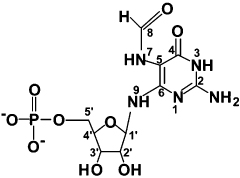Table 2.
13C Chemical Shift and Assignments for [15N5,13C10]-FAPy in 2H2O
| 13C chemical shift (ppm)b | |||
|---|---|---|---|
| structure | carbona | α | β |
 |
2 | 154.99 br s | |
| 4 | 162.15 br d | ||
| (93) | |||
| 5 | 89.30 ddd | ||
| (78, 85, 18c) | |||
| 6 | 160.66 dd | 161.48 dd | |
| (74, 20c) | (74, 20c) | ||
| 8, cis | 165.89 d | 166.23 d | |
| (13.3c) | (13.5c) | ||
| 8, trans | 171.02 d | 171.11 d | |
| (13.9c) | (13.7c) | ||
| 1′ | 81.93 dd | 85.30 dd | |
| (39, 11c) | (44, 12c) | ||
| 2′ | 71.93 t | 73.92 dd | |
| (38) | (44, 34) | ||
| 3′ | 70.70 t | 71.37 t | |
| (38) | (38) | ||
| 4′ | 81.71 ddd | 83.20 ddd | |
| (35, 41, 8d) | (35, 41, 8d) | ||
| 5′ | 64.75 d | 64.92 dd | |
| (43) | (43, 5d) | ||
For clarity, the numbering scheme shown here reflects that of the pyrimidine product. The structure, as drawn, corresponds to the β, cis configuration of FAPy.
The values in parentheses are the coupling constants to 13C nuclei (in Hz) except as indicated by superscripts. Chemical shifts are referenced to internal CH3OH standard at 49.50 ppm.
The values correspond to the coupling constant to 15N.
The value represents the coupling constant to 31P.
